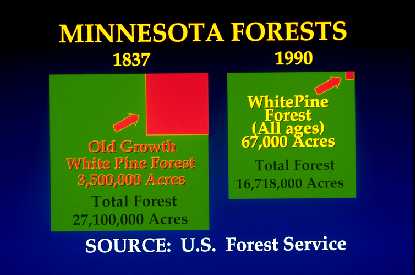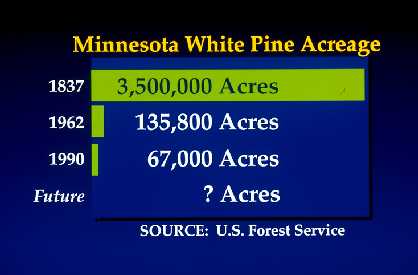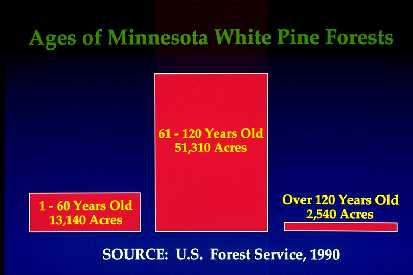










|
|
Minnesota's White Pines:
Our Vanishing Heritage
|
 |
|
In 1837, when cutting began, 3,500,000 acres of
Minnesota forest were dominated by white pines;
by 1990, only 67,000 acres were. 98% of Minnesota's
white pine forest has been lost. Only 2% of
Minnesota's white pine forest have grown back
as white pine after cutting. We must develop
a sustained yield management plan before we
cut this last 2%. This 67,000 acres includes
all public and private land throughout Minnesota.
|
|
| |
|
 |
|
Most of our white pine acreage was lost before 1962.
With no sustained yield plan, Minnesota lost over
half of its remaining white pine acreage in the last
30 years. Cutting continues.
|
|
| |
|
 |
|
Fully grown white pines 3-6 feet in diameter, the
crown jewels of our northern forests, have all but disappeared. Most
of our remaining white pine forests are second-growth stands that are
mostly about a quarter grown. Most are only 61 to 120 years into their
400-year lifespans. If they were to be cut, too few young white pines
exist to replace them. Major causes for this lack of young trees are
lack of planting and failure to protect seedlings from deer browsing,
blister rust and competition. At present, industry is not required to
pay the full cost of replacing white pines they cut on public land.
Cutting without replacement must end. |
|
| |
|
 |
|
White pines have declined more in Minnesota than
anywhere in the nation. For example, Minnesota once had twice as much
white pine acreage as New Hampshire but now has less than a 20th as
much. Minnesota now produces less than 1% of the nation's white pine
lumber. It's time to restore this valuable resource to the Minnesota
ecosystems it once dominated. Restoration work will create many jobs
now and in the future. A youth conservation corps could be created.
White pines were once Minnesota's most valuable renewable resource.
Millions of acres now have no white pine seed source. Our remaining
scattered white pines must be saved as native seed trees while
scientists develop better methods for helping seedlings survive to
maturity. Cutting them now would destroy future timber value, future
jobs, tourism value, and wildlife habitat. White pines are habitat for
a host of birds, mammals, reptiles, amphibians, and insects. They hold
80% of our bald eagle nests and 77% of our osprey nests.
White pines on public land belong to all Minnesotans--not to
government agencies, the timber industry, or any special interest
group. Minnesota's forests are ours to protect-- out of love for our
children and as stewards of our forests and wildlife. The public will
decide the fate of our white pines by speaking out or failing to speak
out. The most effective action we can take is letting our elected
officials, forest managers and newspaper editors know that we want our
white pines retained and restored. |
|
| |
|
|
|